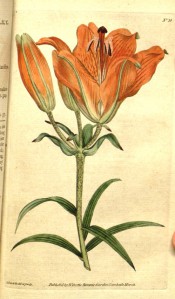Lilium bulbiferum L.
Fully-hardy, vigorous, clump-forming lily with lance-shaped leaves and bulbils produced in the upper leaf axils. In summer it produces 1-5-flowered umbels, occasionally many-flowered racemes, of unscented, bowl-shaped, bright orange-red flowers with black or maroon spots. To 1.5m. Lilium bulbiferum, of more easterly origin than its varieties, such as croceum, is the only form to bear bulbils in its leaf axils. [RHSE, Hortus].
Horticultural & Botanical History
The plant figured in Curtis’s Botanical Magazine as Lilium bulbiferum is probably the variety croceum. ‘The common orange or red lily is as well known in the English gardens as the white lily, and has been as long cultivated here. This grows naturally in Austria and some parts of Italy.’ Dwarf and double varieties are also known, as well as a form with variegated leaves. [BM t.36/1788]. Introduced to Britain in 1596. [PD].
History at Camden Park
Listed in all published catalogues [B.299/1843].
Notes
Published Dec 27, 2009 - 04:59 PM | Last updated Jan 07, 2010 - 01:18 PM
| Family | Liliaceae |
|---|---|
| Category | |
| Region of origin | Southern Europe |
| Synonyms |
|
| Common Name | Orange lily |
| Name in the Camden Park Record |
Lilium bulbiferum |
| Confidence level | high |


